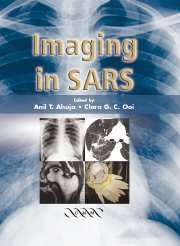Book contents
- Frontmatter
- Contents
- Contributors
- Preface
- 1 The Epidemiology of Severe Acute Respiratory Syndrome: A Global Perspective
- 2 The Role of Emergency Medicine in Screening SARS Patients
- 3 Severe Acute Respiratory Syndrome Outbreak in a University Hospital in Hong Kong
- 4 Imaging of Pneumonias
- 5 The Role of Chest Radiographs in the Diagnosis of SARS
- 6 Chest Radiography: Clinical Correlation and Its Role in the Management of Severe Acute Respiratory Syndrome
- 7 The Role of High-Resolution Computed Tomography in Diagnosis of SARS
- 8 The Role of Imaging in the Follow-up of SARS
- 9 Treatment of Severe Acute Respiratory Syndrome
- 10 SARS in the Intensive Care Unit
- 11 Imaging of Pneumonia in Children
- 12 Imaging and Clinical Management of Paediatric SARS
- 13 Imaging of SARS in North America
- 14 Radiographers' Perspective in the Outbreak of SARS
- 15 Implementation of Measures to Prevent the Spread of SARS in a Radiology Department
- 16 Aftermath of SARS
- 17 Update on Severe Acute Respiratory Syndrome
- Index
7 - The Role of High-Resolution Computed Tomography in Diagnosis of SARS
Published online by Cambridge University Press: 27 October 2009
- Frontmatter
- Contents
- Contributors
- Preface
- 1 The Epidemiology of Severe Acute Respiratory Syndrome: A Global Perspective
- 2 The Role of Emergency Medicine in Screening SARS Patients
- 3 Severe Acute Respiratory Syndrome Outbreak in a University Hospital in Hong Kong
- 4 Imaging of Pneumonias
- 5 The Role of Chest Radiographs in the Diagnosis of SARS
- 6 Chest Radiography: Clinical Correlation and Its Role in the Management of Severe Acute Respiratory Syndrome
- 7 The Role of High-Resolution Computed Tomography in Diagnosis of SARS
- 8 The Role of Imaging in the Follow-up of SARS
- 9 Treatment of Severe Acute Respiratory Syndrome
- 10 SARS in the Intensive Care Unit
- 11 Imaging of Pneumonia in Children
- 12 Imaging and Clinical Management of Paediatric SARS
- 13 Imaging of SARS in North America
- 14 Radiographers' Perspective in the Outbreak of SARS
- 15 Implementation of Measures to Prevent the Spread of SARS in a Radiology Department
- 16 Aftermath of SARS
- 17 Update on Severe Acute Respiratory Syndrome
- Index
Summary
Introduction
Plain radiography and high-resolution computed tomography (HRCT) are the cornerstones for imaging the lungs. HRCT is capable of imaging the lungs with excellent spatial resolution, providing anatomical detail similar to that available from gross pathological specimens or lung slices. It is especially good for the early detection and characterization of localized or diffused lung parenchymal abnormalities. However HRCT involves a high-radiation dose, is not readily available and therefore may not be suitable as the first line of investigation for suspected severe acute respiratory syndrome (SARS) patients or in a screening role in endemic/pandemic situation. In such a situation, HRCT should be reserved for selected group of patients with good clinical indication and non-diagnostic chest radiograph (CXR). The indications should be more relaxed with sporadic cases. The diagnostic protocol for imaging and the use of CXR and HRCT have been discussed previously (Figure 7.1).
Apart from diagnosis, HRCT also plays an important role to monitor progress and response to treatment and for follow-up. These will be dealt with separately in later chapters. This chapter aims to give the reader an insight about the role of HRCT in diagnosis of SARS and to describe various radiological appearances on HRCT.
- Type
- Chapter
- Information
- Imaging in SARS , pp. 69 - 78Publisher: Cambridge University PressPrint publication year: 2004

